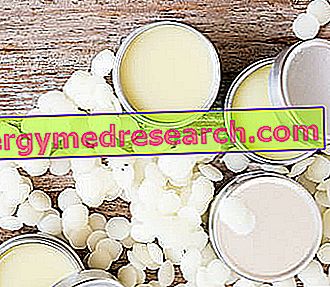Generality
The discoloration of unwanted hair is not a real depilatory technique, nor an epilatory one. This type of treatment, in fact, does not remove the stem or the piliferous root, but limits itself to making the extracutaneous part of the hair less visible, removing - through chemical substances - its natural pigment: melanin.

Indications
In which parts of the body is the discoloration of unwanted hair indicated?
As mentioned, the discoloration of unwanted hair is a technique that uses chemicals to remove the melanin contained in the hair, thus depriving them of their natural pigmentation.
For this reason, bleaching is useful in areas covered with fine, but dark and noticeable hair. The areas on which, normally, the discoloration of unwanted hair is carried out are, in fact:
- The face, to hide the mustache and any hair under the chin and on the sides of the face;
- The arms, to hide the hairs present on the forearms;
- The legs, especially, in the back and inside of the thighs.
For all other areas of the body, on the other hand, it is usually not recommended to bleach unwanted hair, while it would be more appropriate to perform a depilation or epilation, in order to avoid obtaining unsightly and counterproductive results.
Precisely in this regard, it is good to remember that bleaching is not recommended for those with a particularly dark complexion, because it would increase the hair / skin contrast, making the problem more visible and embarrassing (try to imagine the aesthetic effect of a white mustache on a female face particularly tanned ...).
Products
The best known product for bleaching unwanted hair is certainly hydrogen peroxide, used at concentrations of a maximum of 20-30 volumes.
Also available on the market are products for the bleaching of superfluous hair ready for use. These products can be found in any supermarket or perfumery.
Action mechanism
How do products work to bleach unwanted hair?
The products for the discoloration of unwanted hair contain alkaline and oxidizing substances, capable of attacking keratin and inducing a series of modifications to the structure of the hair, including the oxidation of melanin.
The bleaching products that can be purchased at any supermarket or perfumery, on the other hand - in addition to hydrogen peroxide (hydrogen peroxide) - also contain an alkaline activator, such as ammonium bicarbonate, which increases its action by damaging the cuticle and favoring the reaction of oxygen with melanin.
How you do it
How do you bleach unwanted hair?
As just stated, the most well-known bleaching agent is hydrogen peroxide - usually at 20 or 30 volumes - to be applied with a cotton pad on the hair to be lightened. After a few minutes, it should be removed by rinsing thoroughly with cold water; a moisturizing cream will be applied to soften the skin and prevent irritation.
It is a wise behavior rule to avoid exposing the treated area to the sun for at least half a day, and use gloves when applying and removing the product.
Bleaches sold in supermarkets and perfumeries, in general, are used in a similar way to hydrogen peroxide. In any case, it is very important to strictly follow the instructions on the package, always carrying out a preventive tolerability test.
In fact, before using the bleaching creams on large areas of the body, it is advisable to test the product on a small clean skin area, leaving it to act for a few minutes, and then rinse it thoroughly.
In the following 24-48 hours the degree of aggressiveness and the possible appearance of allergic reactions will be evaluated.
The duration of the application, generally 5-15 minutes, must be greater the thicker and darker the hair. In any case, the bleach should not be kept too long on the skin, to avoid running into unpleasant irritations.
As a rule, the discoloration is performed once every 7-14 days, depending on the rhythm of hair regrowth, its color and the area treated. Once the right degree of bleaching has been achieved, the treatments can be performed at a greater distance in time.
Side effects
As a rule, products for bleaching unwanted hair are well tolerated, even if - during their application - a slight stinging or a slight burning sensation could be perceived, however bearable.
In more serious cases, on the other hand, you may experience a real skin irritation. In the event that the perceived burning or stinging were too intense and unbearable it is therefore necessary to immediately rinse the area of application with water and, if necessary, contact your doctor if the situation does not improve in a short time.
Finally, in predisposed individuals allergic and sensitization reactions may occur, hence the importance of always performing preliminary tests on small areas of skin before proceeding to the actual discoloration of unwanted hair.
Contraindications
As reported in the leaflet of the instructions for bleaching products - and of which careful reading is recommended - they should never be applied in the presence of burns, skin inflammation (redness, swelling, itching), warts, wheals, pimples, nodules, cysts, moles, cracks, abrasions, cuts and anything else that may damage the integrity of the skin.
Finally, products for bleaching unwanted hair should not be used near the eye contour and mucous membranes.
Natural and DIY remedies
As part of the fight against unwanted hair, there is no shortage of natural and do-it-yourself remedies to bleach them.
Among the various remedies most commonly used in the home environment, camomile and lemon stand out, two natural ingredients with mild lightening properties.
In this regard, the following are two "do-it-yourself recipes" based on these natural products to be used to bleach unwanted hair.
Bleach the unwanted hair with the Lemon
There are two ways to bleach unwanted hair with lemon:
- The first mode involves cutting a slice of lemon and passing it directly over areas where unwanted down is present. After that, it is advisable to leave for about 20 minutes, after which it is necessary to rinse thoroughly with water. Finally, it is advisable to repeat the treatment at least three times a week.
- The second method, on the other hand, involves mixing the lemon juice with honey, until a sort of creamy dough is obtained which must then be applied to the hair that you want to bleach. After that, leave to work for 30-40 minutes and finally rinse with plenty of warm water. Also in this case, the treatment must be repeated several times over time to obtain the desired effect.
Similarly to what happens for hydrogen peroxide and commercial bleaches, even in the case of discoloration with lemon it is good practice not to expose yourself to the sun immediately after bleaching.
Bleach unwanted hair with Chamomile
Chamomile is a natural lightening whose action is very mild and, therefore, requires a certain consistency in the application.
The DIY recipe for the bleaching of unwanted hair with chamomile, involves the preparation of an infusion of it which will then have to be applied in the form of a pack on the hair that you want to lighten. The shutter speed should be at least 20 minutes.
To achieve appreciable results, this treatment must be repeated at least three times a week.
Warnings
In general, it is always inadvisable to resort to natural or do-it-yourself remedies, both as regards the real effectiveness of such treatments, and as regards their potential dangerousness.
In fact, although in the DIY remedies the ingredients used are all natural and commonly used, there is always the risk that if handled badly by inexperienced hands, or if mixed incorrectly, they may lead to counterproductive results, or worse, cause damage and irritation to the skin.



